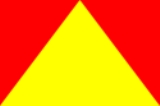
Principality of Trinidad
Encyclopedia
The Principality of Trinidad was declared in 1893, when the American James Harden-Hickey
claimed the uninhabited island Trindade and Martim Vaz
in the South Atlantic and declared himself as James I, Prince of Trinidad. According to Harden-Hickey's plans the island would, after being recognized as an independent country, become a military dictatorship
under his leadership. He designed postage stamps, a national flag, and a coat of arms
; he established a chivalric order
, the "Cross of Trinidad;" he bought a schooner
to transport colonists; he appointed M. le Comte de la Boissiere as Secretary of State and opened a consular office at 217 West 36th Street in New York, and even issued government bond
s to finance construction of infrastructure in the island. Despite his plans, his idea was ridiculed or ignored by the world.
In July 1895, the British
tried to take possession of this strategic position in the Atlantic, basing their claim on the 1700 visit by English astronomer Edmund Halley. The British planned to use the island as a telegraph cable station. However, Brazilian diplomatic efforts, along with Portuguese support, pressed a successful claim to Brazilian sovereignty, based on the island's discovery in 1502 by Portuguese navigators.
In order to clearly demonstrate sovereignty over the island, now part of the State of Espírito Santo
, a landmark was built on January 24, 1897. Nowadays, Brazilian presence is marked by a permanent Brazilian Navy
base on the main island.
James Harden-Hickey
James Harden-Hickey was a Franco-American author, newspaper editor, duellist, adventurer and self-proclaimed Prince.-Early life:James Aloysius Harden was born in San Francisco, California on December 8, 1854...
claimed the uninhabited island Trindade and Martim Vaz
Trindade and Martim Vaz
Trindade and Martim Vaz is an archipelago located about 1,200 kilometers east of Vitória in the Southern Atlantic Ocean, belonging to the State of Espírito Santo, Brazil. The archipelago has a total area of 10.4 km² and a population of 32...
in the South Atlantic and declared himself as James I, Prince of Trinidad. According to Harden-Hickey's plans the island would, after being recognized as an independent country, become a military dictatorship
Military dictatorship
A military dictatorship is a form of government where in the political power resides with the military. It is similar but not identical to a stratocracy, a state ruled directly by the military....
under his leadership. He designed postage stamps, a national flag, and a coat of arms
Coat of arms
A coat of arms is a unique heraldic design on a shield or escutcheon or on a surcoat or tabard used to cover and protect armour and to identify the wearer. Thus the term is often stated as "coat-armour", because it was anciently displayed on the front of a coat of cloth...
; he established a chivalric order
Chivalric order
Chivalric orders are societies and fellowships of knights that have been created by European monarchs in imitation of the military orders of the Crusades...
, the "Cross of Trinidad;" he bought a schooner
Schooner
A schooner is a type of sailing vessel characterized by the use of fore-and-aft sails on two or more masts with the forward mast being no taller than the rear masts....
to transport colonists; he appointed M. le Comte de la Boissiere as Secretary of State and opened a consular office at 217 West 36th Street in New York, and even issued government bond
Government bond
A government bond is a bond issued by a national government denominated in the country's own currency. Bonds are debt investments whereby an investor loans a certain amount of money, for a certain amount of time, with a certain interest rate, to a company or country...
s to finance construction of infrastructure in the island. Despite his plans, his idea was ridiculed or ignored by the world.
In July 1895, the British
United Kingdom of Great Britain and Ireland
The United Kingdom of Great Britain and Ireland was the formal name of the United Kingdom during the period when what is now the Republic of Ireland formed a part of it....
tried to take possession of this strategic position in the Atlantic, basing their claim on the 1700 visit by English astronomer Edmund Halley. The British planned to use the island as a telegraph cable station. However, Brazilian diplomatic efforts, along with Portuguese support, pressed a successful claim to Brazilian sovereignty, based on the island's discovery in 1502 by Portuguese navigators.
In order to clearly demonstrate sovereignty over the island, now part of the State of Espírito Santo
Espírito Santo
Espírito Santo is one of the states of southeastern Brazil, often referred to by the abbreviation "ES". Its capital is Vitória and the largest city is Vila Velha. The name of the state means literally "holy spirit" after the Holy Ghost of Christianity...
, a landmark was built on January 24, 1897. Nowadays, Brazilian presence is marked by a permanent Brazilian Navy
Brazilian Navy
The Brazilian Navy is a branch of the Brazilian Armed Forces responsible for conducting naval operations. It is the largest navy in Latin America...
base on the main island.

